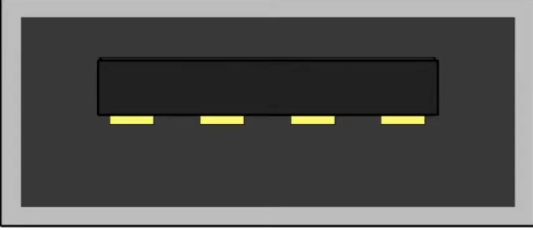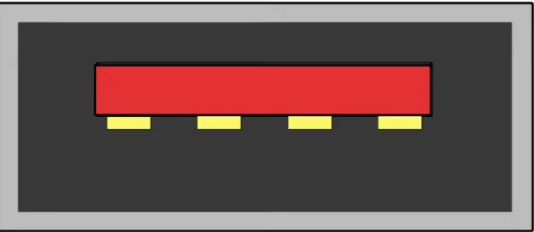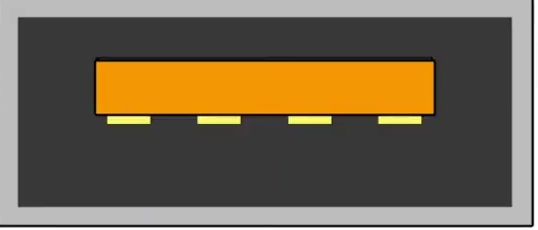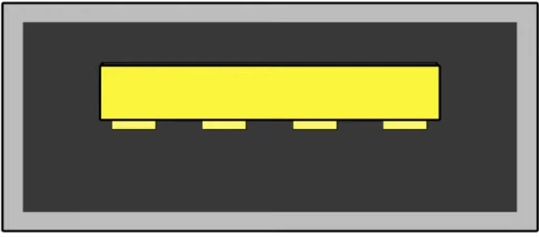USB ports have become a very common part of our everyday electronics. There was a time when these ports were present in motherboards or printers but now these ports are found in the most of our daily usable devices like lamps, machines, adapters etc.
If you have good knowledge of USB ports color coder then it can be helpful for you to identify the capability and functionalities of these ports. You can make good decisions if you know which color corresponds to which standard of USB, data transfer speed, power requirements and device capabilities in which that port is found.
Not only USB ports come in different colors but USB cables also have colors.
In general, Blue USB ports are typically USB 3.0 for high speed data transfer. Black ports which are commonly found in older devices point toward USB 2.0 while white ports are a symbol of fast speed and power delivery in new devices and are USB C. Red, orange, green, yellow, pink, gray purple and transparent USB ports are less commonly used and have indication towards custom configuration and proprietary uses.
USB ports color codes
| NOTE: It is not a standard method to check USB port version using its color because many companies design according to their own standards. However, in most of the cases you can make a true guess if you properly have the knowledge about different color codes and the symbols written beside USB ports. |
White USB ports:
This is the oldest version of ports. These ports are either USB 1.0 or 1.1. Data transfer rate for these ports is very low which ranges from 1.5 up to 12 MBPS. That is the reason these ports are used for connecting the devices which do not require high power such as keyboards, mouse etc.
However, some Apple devices like Macbook, flash drives and iMACs also come with white USB ports. These ports provide power to devices that do not need more than 100 mA.

Black USB ports:
After white USB ports there came Black ports in the market. These ports are USB 2.0 and backward compatible with USB 1.0. Data transfer rate for these ports is 480 mbps.
These are the most commonly found ports. You will easily find these ports on Laptops, PCs, USB hubs and printers. These ports can be used to connect mouse, keyboards, MP3 players, Speakers, HDD which are external, Cameras, CD roms to give power upto 500 mA.

Blue USB ports:
These ports are USB 3.0 and introduced in 2008 after black ports. USB 3.0 is compatible with 2.0 and 1.1 USB ports.
These USB ports are for better data transfer rate and found commonly on laptops and computers to transfer data at 5 gbps. Blue USB ports are also called super speed ports. That is why you will find “SS” symbol beside these ports. It typically powers devices that require 900 mA current or around.

Teal USB ports:
These ports seems to be very similar to blue USB ports but these ports have dark blue color and are USB 3.1 ports.
Teal USB ports transfer data at 10 gbps and are super speed ports. These ports are backward compatible with 3.0, 2.0, 2.1 and 1.1.
Teal ports are double in data transfer when compared to blue. Power rate for these ports is 1.5 A.

Green or Golden USB ports:
These ports are very rare to find and found only on devices which can charge other devices at a high speed. These ports are super charging ports.
Actually, these ports are found on Qualcomm devices or on the devices which make use of Qualcomm quick charge technology. These ports charge four times faster when compared to USB 3.0 ports.
Transparent USB ports:
Many USB ports come with transparent plastic. These ports are common in latest high speed PCs and the color of these ports have nothing to do with its version. They can be usb 2.0, 3.0 or any other.
Red USB ports:
Red usb ports are USB 3.2. These ports are twice fast when compared to 3.1 ports. You will find these ports on high end PCS or laptops.
Red ports are sleep and charge ports like yellow and orange ports.

Orange or yellow USB ports:
Both Yellow and orange ports are sleep and charge ports or you can say that these ports are always on and used for charging devices when the laptop is off.
You can charge your devices connected with this port even if your laptop is sleeping or hibernating or shut down.
The only difference between yellow and orange ports is that orange usb port has specs that of USB 3.0 and yellow has that of 3.0 or 2.0.


USB ports symbols for identification of ports
A usb port with a symbol of “SS” is used to represent a super speed usb port. It is most commonly blue in color.
Bare trident symbol denotes USB 2.0
SS prefix along with trident symbol denotes USB 3.0
If you see 10 written above prong of trident then it is USB 3.1 port
If 20 is written then it is USB 3.2 port.

If the trident is enclosed with a battery like shape then you are looking at a charging USB power delivery port. Sometimes, this symbol is also added with a tiny 10 or 20 adobe it.
If “D” symbol is printed beside the port then it means that this port is also a display port.
If there is only a lightning icon then this port is a thunderbolt3 port which can transfer data at speed of 40 GBPS.
If there is a lightening symbol along with ss trident then this USB port is a fast charging post for charging mobiles and tablets.

Which color USB port charges fast?
When we compare all usb ports then we will conclude that Green and Golden USB ports charge fast. Because both green and golden USB ports are designed specifically for fast charging and commonly found on Qualcomm devices.
Which color USB port is fast in data transfer?
The fastest USB port for data transfer is red which can transfer data at a speed of 20 GBPS. This port is USB 3.2. After that Teal and blue comes which are 3.1 and 3.0 with data transfer speed of 10 GBPS and 5 GBPS.
USB upstream vs Downstream ports
These ports are found on monitors and printers. Upstream port receives data from the device while downstream port sends data to connected device.
Generally, upstream ports are type A ports while downstream can either be A type or B type.
Is color Coding of USB ports standardized?
No, color coding for USB ports is not a standard method for identification of ports. It is always good to see the description of the device to know which port is for which purpose.
However, many devices use color coding of ports along with USB ports symbols for description.
